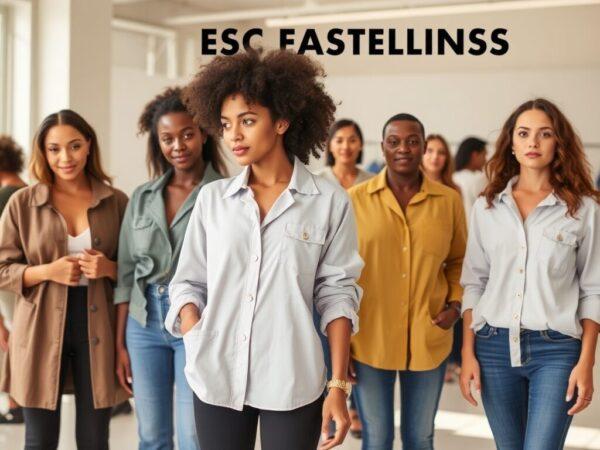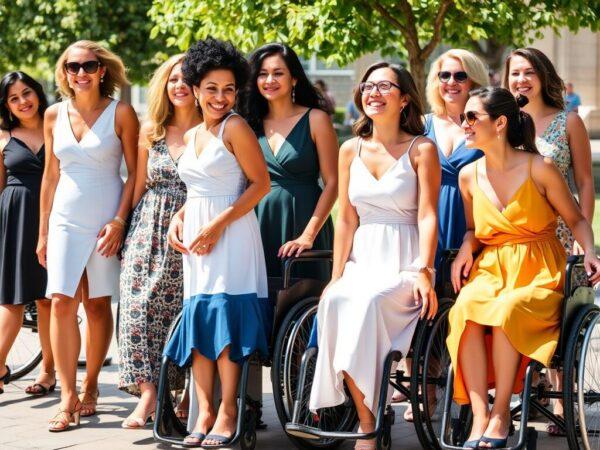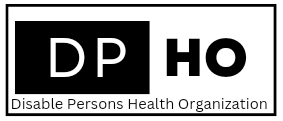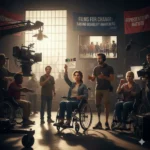
Chic Adaptive Dresses: USA’s Top Trends 2025.
Best dresses for different disabilities. Discover the best adaptive dresses for various disabilities in the USA for 2025. Explore stylish, comfortable, and functional designs with features like magnetic closures, seated cuts, and sensory-friendly fabrics from leading and specialized brands, enhancing independence and self-expression. The landscape of fashion is continually evolving, and nowhere is this more evident than in the burgeoning field of adaptive apparel. In 2025, the United States is leading the charge in offering stylish, functional, and inclusive dresses for individuals with diverse abilities. No longer are adaptive clothes relegated to bland, utilitarian designs; instead, innovative designers and mainstream brands are embracing the philosophy that fashion should be accessible to everyone, regardless of physical challenges or sensory sensitivities. This movement is driven by a profound understanding that clothing is not just about covering the body but about fostering confidence, promoting independence, and expressing personal style. The demand for such garments is rapidly increasing, reflecting a societal shift towards greater inclusivity and a recognition of the diverse needs within the consumer market. From magnetic closures that simplify dressing to thoughtfully designed silhouettes for wheelchair users, the adaptive dress market in the USA is experiencing a renaissance of creativity and practicality. This transformation is empowering individuals to dress with ease, comfort, and dignity, redefining what it means to be fashionable in the modern era.
Magnetic Magic: Effortless Fastenings for All

For many individuals with limited dexterity, fine motor skill challenges, or conditions like arthritis or Parkinson’s, traditional buttons, zippers, and clasps can be incredibly frustrating and even painful. Enter the revolutionary impact of magnetic closures, a game-changer in adaptive dress design. These ingenious fastenings seamlessly snap together with minimal effort, transforming the daily ritual of getting dressed from a daunting task into a simple, empowering act. Beyond their practicality, magnetic closures are often discreetly integrated into garments, maintaining a sleek and sophisticated aesthetic. This innovation not only grants greater independence to self-dressers but also significantly eases the process for caregivers who assist with dressing. The subtle power of magnets eliminates the need for fiddly buttons or stubborn zippers, promoting a sense of dignity and reducing potential discomfort. As a result, adaptive dresses featuring magnetic closures are becoming a cornerstone of inclusive fashion, proving that functionality and elegance can indeed coexist harmoniously.
Seated Style: Dresses Designed for Wheelchair Users

Dresses for wheelchair users often require specific design considerations to ensure comfort, prevent pressure points, and maintain a flattering silhouette while seated. Traditional dresses can bunch uncomfortably, restrict movement, or appear ill-fitting when worn in a seated position. Adaptive designers have meticulously re-imagined dress construction to address these unique needs, creating garments that are as fashionable as they are functional. Key features often include shorter backs to prevent fabric excess, longer fronts for appropriate drape, and strategic side openings or zips for ease of dressing and medical access. Fabrics are carefully selected for their stretch, breathability, and wrinkle-resistance, ensuring all-day comfort. The goal is to provide dresses that not only accommodate the practicalities of wheelchair use but also empower individuals to express their personal style with confidence. This thoughtful approach to design ensures that fashion remains an inclusive and enjoyable aspect of life for wheelchair users, allowing them to participate fully in social and professional settings without compromising on comfort or appearance.
Sensory Comfort: Soft Fabrics and Seamless Designs
For individuals with sensory sensitivities, such as those on the autism spectrum or with tactile defensiveness, the feel of clothing against the skin is paramount. Traditional dress fabrics, rough seams, or irritating tags can cause significant discomfort and even distress. The rise of sensory-friendly adaptive dresses addresses these concerns head-on, prioritizing ultra-soft materials and meticulous construction techniques to create a truly comfortable wearing experience. These garments often feature smooth, flat seams (or entirely seamless designs), tagless labels, and hypoallergenic fabrics like organic cotton, bamboo, or specialized blends that feel gentle against sensitive skin. The emphasis is on breathability and a non-restrictive fit, allowing for freedom of movement without any irritating constriction. This focus on sensory comfort is not merely a luxury but a necessity, enabling individuals to engage in daily activities and social interactions without the distraction of uncomfortable clothing. By eliminating sensory triggers, these adaptive dresses promote a greater sense of calm, well-being, and confidence, allowing wearers to focus on their lives rather than their attire.
Beyond the Basics: Innovative Adaptive Dress Features
The realm of adaptive fashion is constantly innovating, moving beyond fundamental modifications to incorporate cutting-edge features that enhance both form and function in dresses. These innovations are driven by a deep understanding of the diverse daily lives and specific requirements of individuals with disabilities. For instance, some adaptive dresses now integrate discreet access points for medical devices, such as feeding tubes or catheters, allowing for easy management without compromising the garment’s aesthetic. Others feature modular designs, where elements like sleeves or hemlines can be adjusted or detached, providing versatility and catering to changing needs or personal preferences. The use of smart textiles, while still emerging, also presents exciting possibilities for future adaptive dresses, potentially incorporating temperature regulation or posture support. This continuous pursuit of innovation reflects a commitment to creating truly empowering clothing solutions. These advanced features ensure that adaptive dresses are not just about accommodating a disability but about actively improving quality of life and empowering individuals to live more independently and stylishly.
Adjustable Hemlines: Versatility for Every Occasion
Adjustable hemlines represent a significant stride in adaptive dress design, offering unparalleled versatility and functionality. For individuals with fluctuating needs, such as those who use different mobility aids (e.g., a wheelchair at times, a walker at others) or experience changes in body shape, the ability to modify a dress’s length is invaluable. These innovative designs often incorporate hidden drawstrings, snap systems, or clever folding mechanisms that allow the wearer or caregiver to easily lengthen or shorten the hem as needed. This adaptability means a single dress can seamlessly transition from a more casual, shorter length suitable for ease of movement to a longer, more formal length for special occasions. Beyond practicality, adjustable hemlines contribute to a sense of empowerment, allowing individuals to customize their look and feel confident in their attire for any situation. This thoughtful design element not only extends the lifespan and utility of a garment but also reflects a deeper understanding of the dynamic nature of living with a disability, promoting both style and practicality in equal measure.
Discreet Access: Integrating Medical Device Accommodation
One of the most profound innovations in adaptive dress design is the thoughtful integration of discreet access points for medical devices. For individuals who rely on feeding tubes, ostomy bags, PICC lines, or other essential medical equipment, traditional clothing can present significant challenges, often requiring uncomfortable workarounds or compromising privacy and dignity. Adaptive dresses are now being meticulously designed with hidden zippers, cleverly placed button plackets, or subtle openings that allow for easy, quick, and private access to these devices. These features are often camouflaged within the garment’s overall design, ensuring that the dress maintains a stylish and mainstream appearance. The benefit extends beyond mere convenience; it significantly enhances the wearer’s sense of comfort, confidence, and independence. No longer do individuals have to choose between their health needs and their desire to dress fashionably. This thoughtful consideration for medical accommodation exemplifies the true spirit of inclusive fashion, demonstrating that design can indeed serve both practical necessities and personal expression seamlessly.
Stylish Solutions: Adaptive Dresses for Specific Needs
The evolution of adaptive fashion is marked by its increasing specificity, offering tailored solutions for a wide array of disabilities while refusing to compromise on aesthetic appeal. Rather than a one-size-fits-all approach, designers are now deep-diving into the unique challenges and preferences associated with particular conditions, resulting in dresses that are not only highly functional but also genuinely fashionable. This targeted design philosophy ensures that individuals no longer have to settle for ill-fitting or uninspired clothing. Whether it’s a dress crafted to accommodate prosthetics with elegant ease, a garment engineered for effortless donning and doffing for those with limited arm mobility, or a piece designed to provide calming compression for sensory needs, the market for adaptive dresses in the USA is bursting with innovative and stylish options. This focus on specific needs underscores the industry’s commitment to truly inclusive design, recognizing that every individual deserves access to clothing that makes them feel confident, comfortable, and empowered. The emphasis is on celebrating individuality and offering choices that reflect diverse lifestyles and aesthetic preferences.
Amputee-Friendly Designs: Prosthetic-Ready Dresses
For individuals with limb loss who use prosthetics, finding dresses that fit well, accommodate the prosthetic comfortably, and maintain a stylish appearance can be a significant hurdle. Traditional dresses often don’t account for the volume or contours of a prosthetic, leading to awkward fits or discomfort. Amputee-friendly adaptive dresses address these issues with thoughtful design modifications. These may include strategic stretch panels, adjustable elements, and generous cuts in specific areas to ensure a smooth, comfortable fit over a prosthetic limb. Fabrics are often chosen for their durability, breathability, and ability to drape well without clinging or snagging. Some designs incorporate clever openings or closures that allow for easier dressing and undressing, especially for those with upper limb prosthetics or limited dexterity. The aim is to create dresses that seamlessly integrate with the prosthetic, allowing the wearer to move freely and confidently. This specialization in design ensures that fashion remains a source of self-expression and empowerment for amputees, promoting a sense of normalcy and style rather than highlighting perceived differences.
Easy-On/Easy-Off: Dresses for Limited Arm Mobility
Dressing can become a challenging daily task for individuals experiencing limited arm mobility due to conditions such as stroke, cerebral palsy, or shoulder injuries. Reaching overhead, manipulating small fasteners, or pulling garments over the head can be difficult or even impossible. Adaptive dresses designed for limited arm mobility revolutionize this process by prioritizing ease of donning and doffing. These designs often feature open-back or open-side closures, utilizing accessible fasteners like magnetic snaps, large Velcro tabs, or extended zipper pulls that can be managed with minimal hand dexterity or even one hand. Wrap-around styles, wide necklines, and generous armholes are also common features, allowing the dress to be slipped on with ease. The goal is to eliminate the need for overhead reaching or complex movements.
These dresses not only restore independence to the wearer but also simplify the dressing process for caregivers. By focusing on practical accessibility without sacrificing style, these adaptive dresses ensure that individuals with limited arm mobility can enjoy a diverse wardrobe that meets their functional needs and personal aesthetic preferences.
Here are 10 FAQs about the best dresses for different disabilities in the USA, with a focus on trends and availability in 2025:
Best Dresses for Different Disabilities in USA, 2025: 10 FAQs
1. What is “adaptive clothing” and how does it apply to dresses in 2025?
Adaptive clothing refers to garments specifically designed with modifications to make dressing easier, more comfortable, and more accessible for individuals with disabilities, chronic conditions, or temporary mobility challenges. In 2025, adaptive dresses continue to evolve beyond purely functional designs, increasingly blending innovative features with contemporary fashion trends, ensuring style is not sacrificed for accessibility.
2. What are the key features to look for in adaptive dresses for wheelchair users in 2025?
For wheelchair users in 2025, key features in adaptive dresses include “seated cuts” (shorter fronts, longer backs to prevent bunching), open-back designs with easy closures (Velcro, snaps, magnets) for assisted dressing, side zippers or discreet openings for independent dressing while seated, and flat seams to prevent pressure points. Stretchable and breathable fabrics are also crucial for comfort.
3. How do adaptive dresses cater to individuals with dexterity challenges (e.g., arthritis, Parkinson’s)?
Adaptive dresses for dexterity challenges in 2025 primarily feature easy-to-use closures such as magnetic buttons, large zipper pulls, or Velcro fasteners, replacing traditional buttons and intricate zippers. Designs may also include wider neck openings, wrap-around styles, or side-opening dresses to minimize the need for fine motor skills.
4. What advancements in adaptive dresses are we seeing for sensory sensitivities (e.g., autism, SPD) in 2025?
In 2025, adaptive dresses for sensory sensitivities are increasingly prioritizing ultra-soft, breathable fabrics like organic cotton, bamboo, or modal. They feature tagless labels (often heat-pressed), flat seams, and sometimes even seamless construction to minimize irritation. Some innovations include compression elements or calming textures discreetly integrated into the fabric.
5. Are adaptive dresses available in a wide range of styles and for formal occasions in 2025?
Yes, absolutely! The adaptive fashion industry has made significant strides by 2025. You can find adaptive dresses in a vast array of styles, from casual everyday wear and work-appropriate designs to elegant evening gowns and formal attire. Major brands and specialized designers are committed to offering stylish options that cater to diverse personal tastes.
6. Which mainstream fashion brands in the USA are offering adaptive dress lines in 2025?
By 2025, several prominent mainstream brands in the USA have robust adaptive lines, including Tommy Hilfiger Adaptive, which is a leader in stylish adaptive wear. Retailers like Zappos Adaptive, Target, and Kohl’s also offer a growing selection of adaptive clothing, including dresses, making inclusive fashion more accessible.
7. Where can I find specialized adaptive dress brands in the USA in 2025?
Beyond mainstream brands, several specialized companies focus entirely on adaptive clothing. In 2025, notable specialized adaptive dress brands in the USA include IZ Adaptive, known for sophisticated seated-fit designs; Silvert’s, which offers a wide range of easy-dressing options often for assisted dressing; Joe & Bella (focusing on ease for older adults); and emerging brands like Lady Fines Fashion Brand which prioritize both style and function.
8. Is custom tailoring an option for adaptive dresses in 2025, and how can it help?
Yes, custom tailoring remains a valuable option for adaptive dresses in 2025. It allows for highly personalized modifications to address specific needs not met by off-the-rack options, such as unique prosthetic accommodations, precise medical device access points, or specialized fit adjustments for unique body shapes, ensuring maximum comfort and functionality.
9. How do adaptive dresses promote independence and dignity for individuals with disabilities?
Adaptive dresses empower individuals by simplifying the dressing process. Features like easy closures and accessible designs reduce the reliance on caregivers, allowing people to dress themselves with greater ease and less frustration. This increased independence directly contributes to enhanced dignity, self-esteem, and the ability to express personal style.
10. What should I consider when choosing the “best” adaptive dress for myself or a loved one in 2025?
When choosing an adaptive dress in 2025, consider the specific disability and its impact on dressing, desired level of independence (self-dressing vs. assisted dressing), type of occasion, preferred fabric textures (especially for sensory needs), and personal style. Reading reviews, checking sizing guides carefully (especially for seated measurements), and consulting with occupational therapists can also be very helpful.
- #AdaptiveFashion
- #AdaptiveClothing
- #InclusiveFashion
- #FashionForEveryBody
- #DisabilityFashion
- #AccessibleFashion
- #FashionForAll
- #BeyondTheChair
- #DisabilityStyle
- #FunctionalFashion
- #MagneticClosures
- #EasyDressing
- #SeatedWear
- #SensoryFriendly
- #DignifiedDressing
- #ComfortableFashion
- #PostSurgeryWear
- #CaregiverFriendly
- #DisabledAndStylish
- #InclusionMatters
- #RethinkFashion
- #AdaptiveCommunity
- #FashionRevolution
- #TommyHilfigerAdaptive
- #ZapposAdaptive
- #IZAdaptive
- #Silverts
- #JoeAndBella
- #LadyFines
- #NikeFlyEase
- #TargetAdaptive
- #KohlsAdaptive
- #AdaptiveFashion2025
- #USAdaptiveFashion
- #MadeInUSA
- #MagneticClosures


